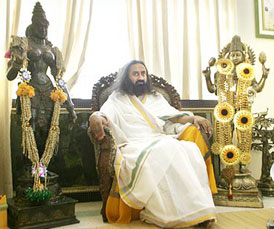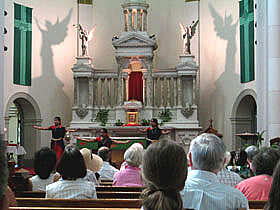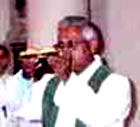 |
The Hindu "Mass" is a "syncretistic liturgical blend [which] will not attract any intelligent Hindu to the Church, but it will break the Church's unity. In this way a new sect will be born: a Hindu-Christian one...." —Dr. J.P.M. van der Ploeg, OP, † Doctor of Sacred Theology, Doctor of Sacred Scripture, Professor of Theology at Nijmegen University, Member of the Royal Academy of Sciences of the Netherlands |
In adopting forms of expression alien to our Liturgy, ... have they made sure of the specific Hindu ideology underlining those forms? Will it not be said that we are adapting ourselves to one type of Indian culture that is specifically Hindu? —Valerian Cardinal Gracias of Bombay † |
[Dance] cannot be introduced into liturgical celebrations: that would mean bringing into the liturgy one of the most desacralized and desacralizing elements; and this would be the same as creating an atmosphere of profanity which would easily evoke in those present and in those taking part in the celebration worldly places and situations. —Congregation for the Sacraments and Divine Worship, Notitiae, June-July 1975, p. 202 (emphasis added) |
In 1980, Wladyslaw Cardinal Rubin, Prefect of the Congregation for Oriental Churches, forbade the use of OM because it is “an essential, integral part of Hindu worship.” —Cited by Victor Kulanday in The Paganization of the Church in India |
|
| |||||||||||||||||||||||||||||
|
Hindu “Mass” Sparks Violent Altercation in Toronto ChurchyardCornelia R. Ferreira, M. Sc. George’s eyes were glazing over. The “Indian Rite of Mass” was in full swing at St. Ann’s Church in Toronto, Canada, on Sunday, July 2, 2006, and he felt he was being hypnotized by the endless monotonous chants and the flowing hand movements of the Indian dancing girls. Feeling nauseated, he left the front of the church and walked to the back to clear his mind. Along the way he noticed people frozen in the pews as though in a trance.
George and some traditionalist friends had learnt of this event at St. Ann’s through flyers that announced a “Roman Rite Liturgy of the Eucharist with religious cultural adaptations of India, approved by the Catholic Bishops’ Conference of India.” The Presider would be a certain Father Thomas D’Sa, Director of the National Biblical Catechetical Liturgical Centre (NBCLC) of the Indian Bishops’ Conference (CBCI) in Bangalore, India. The flyer pictured a “Jesus” dressed like a Hinduized Catholic priest, squatting in front of a large plate on which rested a huge “host” the size of an Indian unleavened bread called chappati. The Voice of Dance The service (photographed and video-taped by the intrepid band of traditionalist protesters) was a consciousness-raising workshop, with Fr. D’Sa explaining the significance of each dance and ritual. Though cloaked in Catholic terminology, the explanations made it clear that he would be conducting Hindu worship or puja, with the barest essentials of the Mass grafted onto it. (Indeed, as it turned out, missing would be the Creed, Lamb of God and Final Blessing.) In any case, Hinduized Catholics do not use the words “Lord,” “Jesus,” or “God” in the Catholic sense. Hinduized priests admit that people at a puja-Mass “are not praying to some Christian Deity, but to the Deity who is understood and experienced in different ways in different religious cultures and traditions,”[5] i.e., they pray to the pantheistic, universal, impersonal Absolute, the Hindu god.
Let us now return to the Hindu Ordo Mass at the century-old St. Ann’s Church in Toronto. Site of a Native Peoples’ Parish for two decades, it had already been desecrated by Canadian Indian rituals. Before the Mass, Father D’Sa announced he would be explaining the dance gestures and postures as used in “the Indian culture.” He said the Entrance Procession would be preceded by an opening dance honouring the Blessed Trinity. The three barefooted Nrityavani dancing girls positioned in front of the altar were introduced respectively as representing, by their gestures, the Father, Son and Holy Spirit.
The Blessed Trinity Dance featured the chanting of the magic (occult) mantra OM as each “Person” of the Trinity came “on stage.” Hinduism teaches that we need to develop the inner consciousness of our divinity and our oneness with the Absolute. Mantra vibrations induce a trance (recall George’s unease) in which we can feel ourselves one with the Supreme Divinity. OM is the supreme vibration as it means “I Am” (appropriating the name by which the true God revealed Himself!). It began creation and initiates awareness. For this reason, and because “Divinity alone can worship Divinity,” every puja must start with OM, to help us recognize our “I Am”-ness and oneness. Mantras and hand gestures also allegedly purify and divinize the body.[10]
After the Blessed Trinity Dance and Entrance Procession, the priests were greeted with an arati of lights, after which Father D’Sa performed the same arati towards the people.
Father D’Sa was disingenuous in describing arati as a mere “welcoming gesture” instead of as the most important ritual in Hindu worship. Arati is defined as a temple ritual in which a fire or light on a plate is waved in a clockwise direction in front of a deity, an important person, or anything valuable. Light is worshipped as the Supreme Lord of inner consciousness. The clockwise direction symbolizes one’s divinity, revealed by the “flame” or light of knowledge. Fire and light themselves are worshipped. Indeed, the puja-Mass was advertised in the flyer as “Divya Yagam,” a term meaning “worship of the Light.” Arati is also done to appease the goddess Arathi and to counteract “the evil eye.” Further, the Hindu gods demand adoration with flowers, incense and light.[13] It just so happens that the puja-Mass featured a triple arati of fire, flowers and incense sticks later in the proceedings.
At the Kiss of Peace, the congregation was told to fold their hands and do the Indian greeting of namaste to their neighbors. Namaste means “the god in me honors the god in you.” It awakens the third eye of the greeter to worship the god in the greeted.[16]
Another abomination took place at the Our Father. Instead of reciting the prayer together as a congregation, the people were asked to sit down while the girls launched into another interpretive dance number. Most gestures were completely unfathomable, with the exception of receiving bread and forgiving trespasses (a shove, hurt feelings, forgiveness, hugs all around). The musical accompaniment was a Hare Krishna chant! Father D’Sa intoned the words “Our Father” four times. The response each time was the mantra “Hare Krishna”; towards the end of the prayer, the mantra was repeated over and over. Krishna, the reincarnation of Vishnu, who represents the Absolute Lord, is said to have seduced 16,000 women, and a whole occult, erotic literature has been developed around this aspect of Krishna.[17] The words “Hare Krishna” mean “O energy of the Lord (Hare), O Lord (Krishna), please engage me in your service!” This energy is actually the goddess Radha, Krishna’s chief consort, who “helps the devotee achieve the grace of the supreme Father,” Krishna, who reveals himself to the sincere devotee. The mantra “Hare Krishna” is thus supposed to awaken spiritual consciousness.[18] Throughout the blasphemous puja-Mass, George’s friends Joan and Rose sat at the back, praying Rosaries, Litanies and other prayers. They spoke audibly, but quietly, “so that people would know something was wrong.” Right after the service, they started passing out copies of the Mother Teresa article to people inside the church. A Sister of St. Joseph (in plainclothes) testily enquired, “Did you get Father’s permission?” “It’s sad,” she said, reacting to the day’s events. “It’s very, very sad.”
1. This is well documented in Victor J. F. Kulanday, The Paganization of the Church in India, 2d rev. ed. (San Thome, Madras: 1988).
2. Cornelia R. Ferreira, “Mother Teresa ‘Beatified’ with Idolatrous Rites,” Catholic Family News, January 2004 (also available as CFN Reprint No. 902 for US $2.50).
3. The original version is described in Kulanday’s book.
4. Ferreira, ibid.
5. India: The Lotus and the Cross, television documentary produced by Vishnu and Rita Mathur, SilverTouch Productions [Toronto], 2004.
6. Father Aidan Turner, “Man of Vision Bring [sic] Indian Dancers to Mass,” in “Diocesan News,” The Voice, thevoiceonline.org, August 2005.
7. Ibid.; www.st-augustines-high.lancsngfl.ac.uk/index.html (click on News, “Recent Events, “Nrityavani, June 1, 2005). The website lauds the troupe for spreading the Gospels “via Asian Dance,” thus disguising its Hindu-evangelizing nature even further.
8. “Silver Jubilee 2006,” artofliving.org.
9. Jessie Rodrigues, “Bangalore: NBCLC Honours Art of Living Guru Sri Sri Ravi Shankar”.
10. Swami Bhajanananda Saraswati and Brahmachari Parameshwara, "The Art of Seeing God,” kalimandir.org/library/art-of-seeing-god/; Ashok Basargekar, “Perceiving the True Identity of the Absolute,” geocities.com/Athens/Acropolis/8891/pooja.txt; “Om: Symbol of the Absolute,” hinduism.about.com/od/omaum/a/meaningofom.htm.
11. Ferreira, ibid.; “Attributes of Ganesha,” templenet.com/beliefs/whoisganesha.htm.
12. John B. Noss, Man’s Religions, 3d ed. (New York: The Macmillan Company, 1963), p. 279; Kulanday, pp. 82-83, 151.
13. Ferreira, ibid.
14. Articles on the dot can be found at experiencefestival.com/a/Symbols_in_Hinduism/id/51477; hindunet.org/srh_home/1996_9/msg00176.html; jansarisevak.org.uk/HinduCulture.html; and experiencefestival.com/third_eye_chakra.
15. “Upachara: Offerings,” in “Shri Shri Shiva Mahadeva,” religiousworlds.com/mandalam/shiva.htm; Jayaram V., “Ashtadikpalas: Rulers of the Eight Directions,” hinduwebsite.com/hinduism/dikpalas.asp; “Perceiving the True Identity.”
16. See experiencefestival.com/namaste.
17. Noss, pp. 287, 289-90.
18. “Maha-mantra,” krishna.com/en/node/638; A. C. Bhaktivedanta Swami Prabhupada, “Chanting Hare Krishna,” harekrishnatemple.com/bhakta/chapter7.html; “Hare Krishna …,” krishna.org/hare-krishna-hare-krishna-krishna-krishna-hare-hare/; Noss, pp. 289-290. Note: The mantra chanted at the Our Father was not the version popularized by the Hare Krishna Movement.
Originally published in Catholic Family News, August 2006. Copyright © 2008-2025 Canisius Books. All rights reserved. |
|||||||||||||||||||||||||||||
People who Indianize ... are members of the Church who are out to destroy the Catholic Church.Archbishop Justin Diraviam |
Unless the present mad craze to paganize the Faith is checked and given up, the 21st century will only see a hybrid form of Christianity, hardly alive but suffocated and perishing. God forbid that such a catastrophe should happen. But happen it will unless the Holy See realizes the danger and acts firmly and quickly.Victor Kulanday |
Click here if you want to be notified when the |
True Catholic Liturgy Explained! |
 Buy now! |
Read about syncretism's part in the New World Order: |

 Now, in February 2006, the occult humanitarian Art of Living Foundation, a United Nations non-governmental association founded by Sri Sri Ravi Shankar (not the sitarist), held an interfaith Jubilee celebration. It drew 2.5 million people, the “first ever ‘spiritual Olympics,’” who meditated together as a “One-World Family.” Dignitaries included the Archbishop of Bangalore and over 1,000 spiritual leaders, as well as World Bank executives, NASA engineers, movie stars, heads of government and Nobel Laureates. Former Dutch Prime Minister Ruud Lubbers was also present; he is a partner of Mikhail Gorbachev in promoting the Earth Charter, and also Hans Küng’s associate for the anti-Christian Global Ethic. In line with Shankar’s philosophy, Indian President A. P. J. Abdul Kalam suggested using music “as a binding force” for the world’s religions to promote an enlightened society and world harmony. Shankar also believes that “[e]ven inside the devil there is divinity, but it is sleeping. When it wakes up, the devil simply disappears.”[
Now, in February 2006, the occult humanitarian Art of Living Foundation, a United Nations non-governmental association founded by Sri Sri Ravi Shankar (not the sitarist), held an interfaith Jubilee celebration. It drew 2.5 million people, the “first ever ‘spiritual Olympics,’” who meditated together as a “One-World Family.” Dignitaries included the Archbishop of Bangalore and over 1,000 spiritual leaders, as well as World Bank executives, NASA engineers, movie stars, heads of government and Nobel Laureates. Former Dutch Prime Minister Ruud Lubbers was also present; he is a partner of Mikhail Gorbachev in promoting the Earth Charter, and also Hans Küng’s associate for the anti-Christian Global Ethic. In line with Shankar’s philosophy, Indian President A. P. J. Abdul Kalam suggested using music “as a binding force” for the world’s religions to promote an enlightened society and world harmony. Shankar also believes that “[e]ven inside the devil there is divinity, but it is sleeping. When it wakes up, the devil simply disappears.”[














 Finally came the mutual gestures of appreciation between the two priests. The pastor announced a second collection to defray the touring expenses of the troupe. In gratitude for his hosting of the “Indian Order of the Eucharist,” the pastor was presented with a garland of flowers and a large picture of “Jesus as an Indian [i.e., Hindu] guru, Jesus in contemplation.”
Finally came the mutual gestures of appreciation between the two priests. The pastor announced a second collection to defray the touring expenses of the troupe. In gratitude for his hosting of the “Indian Order of the Eucharist,” the pastor was presented with a garland of flowers and a large picture of “Jesus as an Indian [i.e., Hindu] guru, Jesus in contemplation.”
